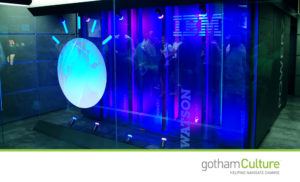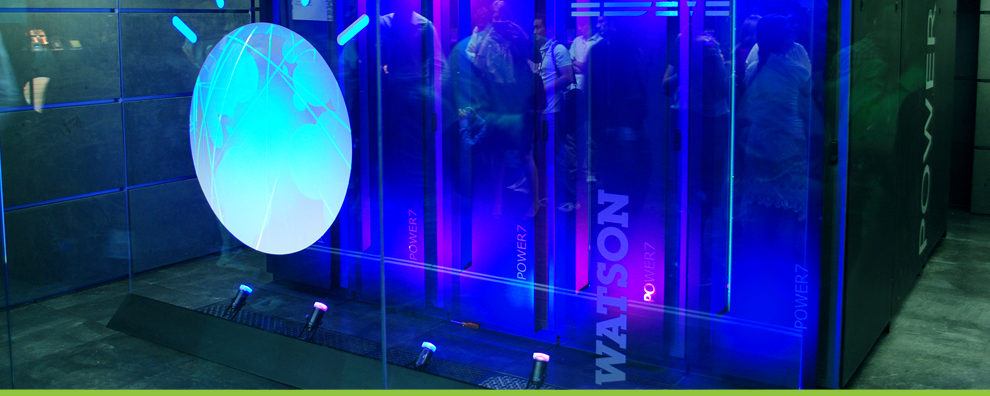In a world where the term “big data” is being thrown around like the next coming, many business leaders still struggle to understand how more information is going to help them make better decisions that drive their businesses forward.
But the real challenge goes well beyond merely accessing more data. The key is accessing data in the right way, at the right time, and in the right format to generate beneficial insights.
This process is no small feat. It requires both technology and human analysis in order to identify these critical insights for business leaders. It has historically meant a team of highly specialized data analysts spending hours upon hours sifting through terabytes (or more!) of information to make it digestible and useful.
But that’s all about to change in a big way.
Meet Watson, IBM’s groundbreaking effort to change the future as we know it using Artificial Intelligence (AI).
“Five years ago, IBM built this system made up of 90 servers and 15 terabytes of memory—enough capacity to process all the books in the American Library of Congress,” states Charlie Rose in a recent 60 Minutes feature. “That was necessary because Watson is an avid reader—able to consume the equivalent of a million books per second. Today, Watson’s hardware is much smaller, but it is just as smart.”
IBM has invested billions of dollars and gathered some of the most brilliant scientific minds available to move AI past its current application in smart phones and home appliances.
Back in 2011, Watson landed a spot on the game show “Jeopardy!” to compete against two of the show’s champions. IBM’s computer system won that night, but IBM has its sights set on much bigger and more meaningful goals.
How Watson is Helping Cancer Patients
 Oncology teams currently review cancer patient cases and studies themselves, working diligently to develop treatment strategies. But consider this: each day over 8,000 new clinical trials and studies are published on the topic. The sheer amount of data is simply impossible to keep up with. Meaning, these review teams must design treatment strategies based on incomplete or outdated information.
Oncology teams currently review cancer patient cases and studies themselves, working diligently to develop treatment strategies. But consider this: each day over 8,000 new clinical trials and studies are published on the topic. The sheer amount of data is simply impossible to keep up with. Meaning, these review teams must design treatment strategies based on incomplete or outdated information.
Regardless of how hard these teams work, they can’t possibly be expected to keep up with the most current information available; information that could possibly inform the development of less destructive, more effective cancer treatment strategies.
Watson is currently being tutored by twenty top cancer institutes. It can read the equivalent of one million books per second, and it never forgets. As Watson is given data, it continues to learn, something that its computer forefathers were incapable of doing.
Using machine learning algorithms, Watson is able to draw its own conclusions based off of the massive amounts of information it consumes. After reading twenty-five million medical studies and trials (its first week on the job, mind you) and scanning the internet for additional trial information, Watson was put to the test, analyzing one thousand actual oncology cases alongside oncology review teams.
The result? In 99 percent of cases, Watson drew the same conclusions as its human counterparts. But that’s not the really exciting part. In 30 percent of those cases, Watson found something new.
By accessing the latest, up-to-the-minute research, Watson was able to identify new strategies that the review team would have otherwise missed.
And now, IBM is making this technology available to employees. As of January 1st, 2017, qualifying IBMers and their covered family members and partners will have access to Watson’s oncology services. This announcement opens new horizons for their employees, as well as another opportunity to develop Watson through actual case studies.
What’s Next for Watson?
For those of you imagining the day Terminators take over, rest easy that IBM’s vision is for AI to be used for very specific tasks that augment human decision-making, keeping machines dependent on man.
Take, for instance, how Watson was used as a teaching assistant in an AI class at the Georgia Institute of Technology. “By utilizing AI to handle routine questions and tasks, we are able to free up people’s time so they can focus on adding value in other ways,” says Bob Schultz, General Manager of Smarter Workforce, IBM. “The system can be utilized to drive key insights from massive amounts of information, and it can learn how to present it in a useful way as it learns.”
Imagine the possibilities if your business had this capability to manage data. From recruiting to production, from strategy to employee engagement, work life as we know it would be disrupted in ways that we can’t yet imagine.
While some well-known folks fall on both sides of the AI debate, one thing is undeniable: we’re only just beginning to uncover the potential of this new and exciting technology, and I’ll be continuing to explore this topic further as we learn more.
This article originally appeared on Forbes.

